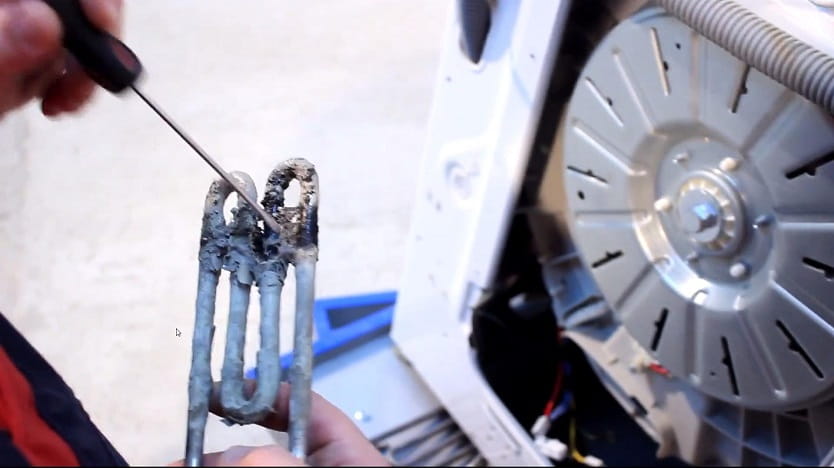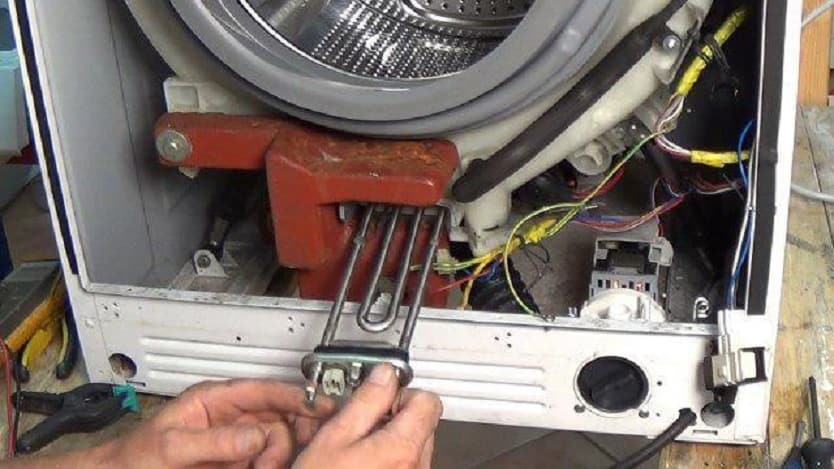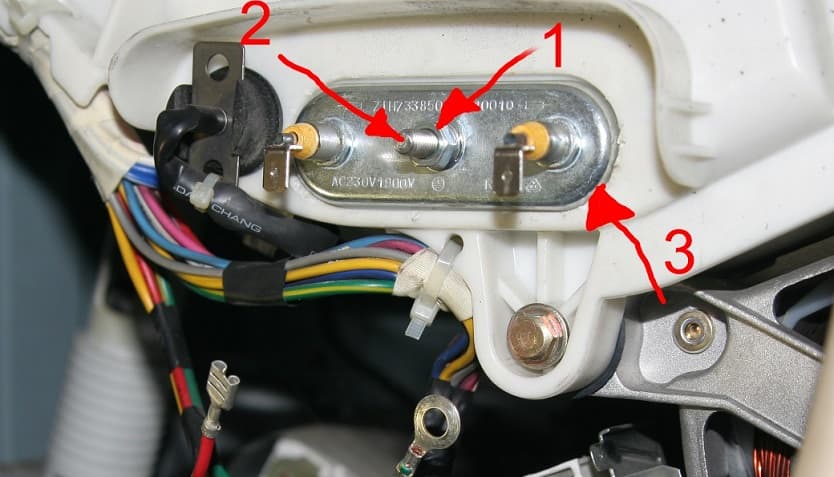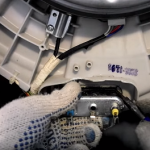The quality of washing depends on the exact execution of the set program by the washing machine, one of the important parameters of which is maintaining the required water temperature. If the water has stopped heating in the automatic machine, then the reason may be the failure of the programmer, the breakdown of the water heating sensor, but most often this is due to the fact that the heating element burned out. In modern models, a breakdown of the heating element can be signaled by a message that appears on the information board.
Reasons for malfunction

TEN (common abbreviation for "tubular electric heater") is a metal tube filled with an electrical insulator with good thermal conductivity. In the middle there is a conductive (fechromic, but more often nichrome) thread that heats up when connected to the network. The heating element in the washing machine serves to heat water in accordance with the programmed program or the temperature set by the user.
The heating element is one of the most prone to breakage parts in a washing machine. On the one hand, this is due to the frequency of operation of the spiral, which either heats up or cools down. But the most common reason why the heating element stopped working is scale deposits caused by the high hardness of the water. A thick layer of scale causes disturbance of heat transfer, the coil overheats and burns out. Replacing the heating element in the washing machine does not require much effort and can be done at home on your own.
![]() See also - How to check the water level sensor in the washing machine
See also - How to check the water level sensor in the washing machine
Preparatory stage
It will not be difficult to buy a new heating element for a washing machine, it is only important that it is intended specifically for this model. Despite the fact that they differ little structurally, there may be some differences in size, spiral shape, etc. In addition, you will need a set of screwdrivers, pipe and wrenches, and a sealant for repairs. It's good if you have a tester or ohmmeter - it will come in handy to make sure that the heating element is malfunctioning or working.
Important:
Before starting work, it is imperative to de-energize the washing machine, disconnect it from the water supply, and also drain the water using the drain filter.
Determine the location of the heating element

Washing machine manufacturers can place heating elements in different places - both in the front and in the back. As a rule, Atlant, Zanussi, Whirpool, Electrolux, Ariston, Indesit and Candy washing machines can have a heater in the back, but Bosch, LG and Samsung often place this element in the front. For automatic machines with vertical loading, access to the heating element can be through the side wall. The easiest way to clarify where the heating element is located in a particular model is by studying the operating instructions or by completing a request on the Internet. Very often, a detailed video is posted on the network of how to change the heating element in a washing machine of a specific model.
Another option is a visual inspection of the back of the washing machine, because to increase maintainability, the designers provided for a fairly simple access to the heating element:
- Ø almost the entire rear area falls on the removable part - it is highly likely that the heating element is mounted at the back
- Ø removable part of a small area - in this case you will have to disassemble the front panel, it is a little more complicated. After all, you will have to remove the top cover, dismantle the tray for powder (detergents), partially disassemble the hatch for linen and only after that remove the front panel itself.
In principle, you can immediately remove the back cover (it's simple, you only need to unscrew a few screws / bolts) to make sure which side the heating element is on.
![]() See also - Why doesn't the washing machine heat the water?
See also - Why doesn't the washing machine heat the water?
Replacing the heating element

It is quite simple to determine the heating element by two characteristic connectors to which the wires are connected. However, if you have an ohmmeter at hand, before removing, it is worth check heating element - the malfunction may not be caused by its failure. The resistance of the heating element in working condition does not exceed 200 Ohm, otherwise it requires replacement.
Important:
Before starting work, we recommend photographing (sketching) the location of the wires and the order of their connection.
Dismantling the electric heater is very simple - it is fastened with just one nut, for this you need a socket wrench. Having unscrewed the nut, it is necessary to lightly knock on the stud, pressing (slightly sinking) it inward. Now that the mount has been removed, you can directly remove the heating element, which is very tightly mounted on the rubber gasket. We recommend using a slotted screwdriver to loosen the seal slightly.
Before installing a new heating element, it is worth checking for operability - there is always a small probability of a manufacturing defect. So it is better to spend a few seconds than to repeat the whole operation of disassembling / assembling the washing machine later. We place the working heating element in its place, carefully monitoring its position - it should sit evenly and tightly, without touching the tank. Fixing the heater by hand, we begin to tighten the nut. To ensure complete waterproofness, the installation site can be additionally treated with a sealant. We tighten the nut on the hairpin tightly, but without excessive efforts. After that, after checking the picture / drawing, we switch the wires. If there are traces of rust or burning on the terminals, they must be removed. If necessary, the terminals can be tightened with pliers to achieve good contact.
We put the protective covers of the case in place - the operation is completed. We carry out control - we turn on the function in which the water heats up over 50 degrees. If the hatch cover heats up, then everything is done correctly.
How much does it cost to change the heating element in a washing machine
The cost of work on replacing the heating element does not take into account the price of a new one, about 1400-2900 rubles. The final amount of the repair is calculated by the master on the spot and depends on the manufacturer and model of the machine. The price includes work on disassembling and removing a faulty heating element, as well as installing a new one and assembling a washing machine.
See also:

